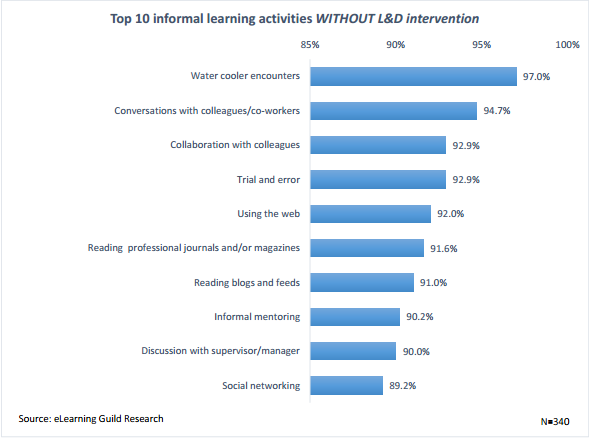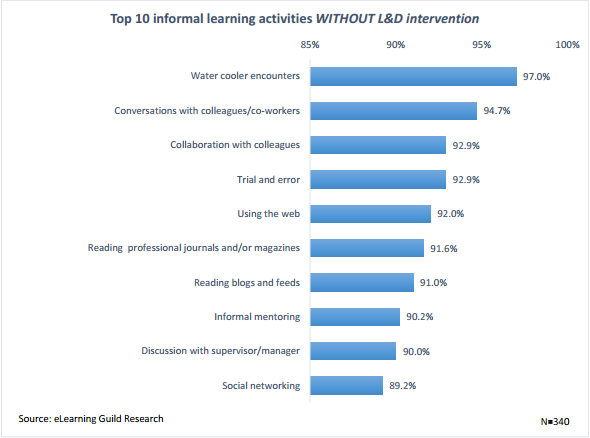 Informal learning in traditional education practices has been understood as ‘learning by experience’ and includes passive activities such as heuristic language building, socialization, inculturation and play (in contrast with teacher-centered learning). Others describe informal learning as a conscious or unconscious activity where learning happens unintentionally due to the consequence of something else.
Informal learning in traditional education practices has been understood as ‘learning by experience’ and includes passive activities such as heuristic language building, socialization, inculturation and play (in contrast with teacher-centered learning). Others describe informal learning as a conscious or unconscious activity where learning happens unintentionally due to the consequence of something else.
With the advent and ubiquity of online learning where teachers are not present, informal learning has come to have a whole new meaning. According research from the eLearning Guild, informal learning has become a “catchall phrase to describe a wide range of new approaches to workplace learning, covering everything from non-traditional approaches to training to autonomous, unplanned individual and team learning.”
Due to the fact that informal workplace learning happens constantly, HR managers are beginning to search for ways to align these activities with business and performance outcomes. Now more than ever, organizations are looking for ways to quantify informal learning so that systems can be embedded for informal learning activities to happen more frequently and in ways that can be measured. According to the eLearning Guild research team, as much as 70-95% of workplace learning happens informally. More specifically, The Architect Development Planner found that managers learnt most successfully from the following three activities:
- 70% from tough jobs
- 20% from people (primarily their boss)
- 10% from courses and reading
Given only 10% of learning comes from areas where organizations typically invest their learning and development budgets, it is important for HR managers to understand how informal learning happens in the workplace. Once we understand how and where informal learning takes place, we can find ways to quantify and embed it so it aligns with business and performance outcomes.
What does informal learning look like?
According to survey respondents, the following are the top 10 informal learning activities that happen without intentional involvement from learning and development managers:

With regards to informal learning activities that are organized by learning and development managers, watching videos, informal approaches within courses and work/job shadowing were most utilized. Here is a list of the additional 7 that are most used:

As you can see there are many different informal learning activities that take place in the workplace which happen either intentionally or unintentionally. The ones that are most used by employees take place unintentionally, without intervention from learning and development managers. This indicates that there are many areas of opportunity for learning and development managers to to provide support so that naturally occurring informal learning can be better aligned to corporate and performance targets.
Support for Informal Learning Activities
How do I provide support for informal learning activities at work and equally important, how do I measure informal learning? These questions are not easy to answer so we know they are are top of mind for HR and learning development managers. We will uncover methods for both evaluating and supporting informal activities in the workplace next week so be sure to look out for the post! Here's a little hint though, in order for informal learning activities to be properly evaluated, it is important that organizations have a performance management system in place. Contact our performance manage experts for guidance on performance and talent management systems.
For content similar to this, check out our webinar on Improving Employee Performance and Engagement.





